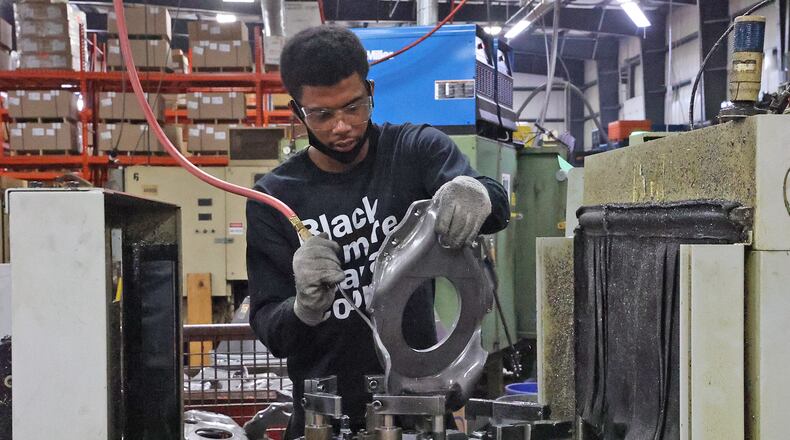“We are in a bad place in terms of the local labor market,” said Ross McGregor, the president of Pentaflex, a manufacturing company in Springfield.
This comes at a time when employers are trying to recruit and maintain workers who have desired skills, especially in manufacturing. McGregor said that can be a difficult task as those workers are limited and highly sought after.
However, the issue is not just limited to skilled laborers. McGregor said his company is also having difficulty filling entry level positions.
“Right now, the big challenge is finding people who are reliable and who will come to work everyday and put in that effort,” he added.
Credit: Bill Lackey
Credit: Bill Lackey
Similar concerns in the region related to labor needs have led to an intense focus on training tied to in-demand jobs, providing everything from basic job-hunting to high-tech skills.
That type of training is not just focused on manufacturing and there is also a high demand for health care training, including registered nurses, licensed practical nurses, respiratory therapists and medical billing, coding and administration.
High demand also exists for commercial truck driver license training.
The CDL program at Clark State College has been operating at half capacity due to the pandemic.
However, the college is continuing to put graduates into the workforce even though space is limited in its Commercial Transportation Training Center due to the pandemic.
Before the pandemic, the college was training 10-12 students per month in the program, which is offered every four weeks, according to representatives of Clark State.
The college is now working to build its capacity back to the pre-pandemic levels.
“The pipeline of new drivers into the industry is significantly less because of the pandemic,” said Bob Costello, chief economist for the American Trucking Associations. ”We trained between 30 and 50 percent fewer drivers in 2020 than we did in 2019.”
The industry lost 45,000 drivers when a new online clearinghouse started last January informing companies when a driver had failed a drug or alcohol test, he said.
Ads for drivers of heavy and tractor-trailer trucks were the most common online job listing in the 12-county JobsOhio West region that includes Clark and Champaign counties.
That comes from data compiled from the state’s OhioMeansJobs.com online portal for the 30 day period ending Jan. 13.
“There’s lots of jobs in trucking,” Costello said. “Pay is absolutely going up. If you’ve been in the industry for a year, you should be making $55,000 if you want.”
Registered nurses are the second most common online job listing, followed by software developers, retail sales supervisors and retail salespersons. The state’s website has nearly 25,000 job listings for the area but some are duplicates and not all companies post ads there, according to the Ohio Department of Job and Family Services.
“There is always a need for nursing staff. There is particularly a need for critical care nurses,” said Sarah Hackenbracht, president and chief executive of the Greater Dayton Area Hospital Association. “But particularly due to COVID-19, we are seeing a need for emergency room staff, specifically nurses.”
The pandemic curtailed nursing instruction but students have returned to clinical rotations at most facilities, she said. Hospitals are working with education partners to address impacts the coronavirus restrictions may have had on nursing students, such as additional hands-on training for those who completed some coursework in a virtual environment, Hackenbracht said.
Credit: Bill Lackey
Credit: Bill Lackey
Training programs proliferate
Across the region, programs exist for companies to train current and prospective employees, retraining for people who’ve lost jobs, internships and apprenticeships for adults, and high-school career technology programs.
Local colleges and universities are increasingly bolstering their traditional offerings with training for non-degree, industry-recognized credentials.
“The two-year colleges are the quick reaction team,” said retired Air Force Col. Cassie Barlow, now president of the Southwestern Ohio Council for Higher Education. “But I’m also seeing with our four-years where they are offering certifications and digital badges and other things along with the degree.”
Interviews with two dozen local and national experts found that one of the biggest challenges — one made more difficult during the pandemic — is getting the word out about training programs, finding job opportunities and picking careers that offer good pay.
“I see all the initiatives that are going on around upskilling and making sure our students are focused on the right majors,” Barlow said. “That’s why I’m so positive about it and so passionate about it.”
Manufacturers’ top concern is finding enough skilled workers, said Angelia Erbaugh, president of the Dayton Region Manufacturers Association. The group is using a state apprenticeship grant to increase the number of people earning credentials, and working with local high schools and colleges to add programs for an industry-recognized production technician certification.
“Industry-recognized credentials ensure that the credential holder has the skills needed to do the job and gives the credential holder a leg up in the hiring and onboarding process,” Erbaugh said.
Places like Clark State have partnered with local companies in order to provide additional training and certifications to employees. Pentaflex, which makes components for the heavy trucking industry, has utilized some of those opportunities.
McGregor said the company offers internal training to upskill employees, but added that external options are helpful in areas such as welding and machining.
McGregor said lessons around robotics and automation will become increasingly important as well since those skills are being utilized more in the manufacturing field.
He added that local companies will be looking to educational partners to help provide opportunities related to those types of training.
Amy Donahoe, the director of Workforce Development with the Greater Springfield Partnership, said that those training opportunities are a huge component in growing the local workforce.
She said those programs, especially those that deal with manufacturing skills, offer employers a chance to upskill current employees and grow talent from within as some have been struggling to find qualified candidates to fill more skilled positions.
Tech-focused credentials
Ohio bested its goal of awarding funding for 10,000 industry-recognized credentials annually under the new TechCred program, which approved funding for 19,841 technology-focused credentials for in-demand jobs between October 2019 and January, according to Ohio Lt. Gov. Jon Husted.
“Technology is changing the type of work that exists and we have to help people earn the skills that we need,” Husted said. “I believe we are doing as well as any Midwestern state is, but if we can produce more talent we will attract more employers and we will create more jobs.”
About 150 companies in Butler, Champaign, Clark, Darke, Greene, Miami, Montgomery, Preble and Warren counties were awarded $2.6 million for current and prospective employees to get 2,866 job skill credentials through December, according to the state. Companies get reimbursed for up to $2,000 for each credential earned.
The state’s Individual Microcredential Assistance Program offers free tech-focused credential coursework for low-income and partially or totally unemployed people.
Ohio Gov. Mike DeWine’s proposed budget includes $70 million to pay for tech-focused credentials, improve workforce efforts in economically distressed rural and urban areas, and collaborate with local partners to expand the state’s skilled workforce.
“We are doing a lot better than we were a few years ago. But I’m not going to suggest that we are doing everything that we need to get done in terms of outcomes,” Husted said. “We have to have people that have the best skills (and have) the most up-to-date schools so that employers say, ‘Yes, I can grow here in Ohio. I have the talent.’”
Trouble filling jobs
Prior to the pandemic, companies’ No. 1 issue was difficulty finding workers with the right skills. That need remains even after the recession left millions unemployed.
Ohio had 307,000 fewer jobs in January than one year prior, according to the most recent U.S. Bureau of Labor Statistics data on total non-farm employment. Nationally employment was down 9.5 million year-over-year in February.
“We have a tremendous number of skilled workers who were working a year ago who are no longer working because jobs are not available to them,” said Michael Shields, a researcher at Policy Matters Ohio.
A huge factor that experts say has driven women in particular out of the workforce is the need to supervise children due to remote schooling or shuttered child care. Other people leave the workforce after becoming discouraged about finding a job or they retire.
Employers who have a reputation for robust safety protocols have less trouble hiring people, Joanie Krein, vice president-market manager for Manpower in Dayton. She said higher pay used to lure workers will linger after the pandemic.
Credit: Bill Lackey
Credit: Bill Lackey
Some employers say the problem is the $300 extra weekly unemployment compensation people can receive because of federal coronavirus relief, Husted said.
“This could in the end slow our economic recovery,” Husted said. “There has to be a way to protect people who need it, to support people who need it but not create a disincentive for people to go back to work.”
Economists say the enhanced unemployment benefits and direct payments to families kept the nation out of an even worse economic crash last year, because it allowed consumer spending to continue even as 22 million people lost their jobs in March and April.
How to find to a job during the pandemic
The COVID-19 pandemic economic crisis threw millions out of work but as the economy improves and vaccination rates rise, more jobs are opening up.
Here are some things to know about finding work and job training that will make you more competitive in your job hunt.
1. Job and family services offices in each county and the state offer robust resources linking people with jobs and training. The state’s newly redesigned portal is at OhioMeansJobs.com.
2. Money is available to help income-eligible people and dislocated workers get training through government-funded programs offered by state and county governments. Businesses can also get training money.
3. Become proficient at networking online, including on LinkedIn, to find companies and organizations you are interested in. Set up alerts on all job websites and be ready to apply quickly.
4. Practice doing job interviews and be comfortable with video conferencing as you likely will have to do video-based interviews.
5. “Set aside time each day to focus on applications and additional networking,” said Jason Eckert, executive director of career services at the University of Dayton. “The old expression is true: Searching for a new job is itself a job.”
-Lynn Hulsey, Staff Writer






